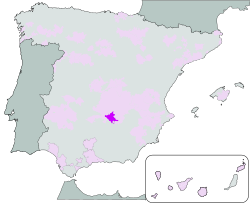Valdepeñas (DO)
| Wine region | |

Valdepeñas DO in the province of Ciudad Real in the region of Castile-La Mancha
|
|
| Official name | D.O. Valdepeñas |
|---|---|
| Type | Denominación de Origen |
| Country | Spain |
Valdepeñas is a Spanish Denominación de Origen (DO) for wines located in the province of Ciudad Real in the south of Castile-La Mancha (Spain). It is almost completely surrounded by another DO (La Mancha) but is an independent DO due to its long history of producing a distinct style of wine known aloque or clarete which is made by mixing white and red grapes. 2016´s harvest is formed by 55.9 million kilos of red grapes and 43.2 million kilos of white grapes.
Valdepeñas is a natural crossroads between the south of Spain, the Mediterranean regions to the east, Extremadura to the west and central plains to the north. To the south of the DO is the Sierra Morena range a natural frontier with Andalusia, and to the east and west there are mountains reaching a height of 1000 m. The most prized vineyards are in Los Llanos in the west and in Las Aberturas in the north. The total area planted to vines is 22,332.11 ha (2016).
Grape growing and wine production in the area was practiced by the ancient Iberians and of course by the ancient Romans. During the Moorish era the area became an important wine producing centre, due to a special concession from the Caliphate of Toledo. After the Reconquest by Christian forces there was a huge increase in demand and in production, and wine began to be shipped further afield to cities such as Madrid. Towards the end of the 18th century annual production was around 200,000 arrobas (3.2 million litres). Fermentation was carried out in enormous earthenware vats (with capacities of up to 1,600 litres) which were partially buried in the ground to help keep the temperature down. During the winter months the lees would fall to the bottom naturally and it was not necessary to clarify the wine.
In 1861 a railway line connected Valdepeñas to the coast and there was a further large increase in wine production this time for export abroad, especially to the Philippines and to South America. In 1895 the ‘Wine Train’ (tren del vino) began to ship wine to Madrid. In 1911 the phylloxera plague destroyed the vineyards, but the producers of the area were able to save their industry by grafting new varieties of grapes (especially Airén) onto phylloxera-resistant New World . This moment of crisis forced the different producers to cooperate with each other and a regional federation was formed, which was subsequently transformed into the Regulatory Council of the DO. Official DO status was granted in 1932.
...
Wikipedia
